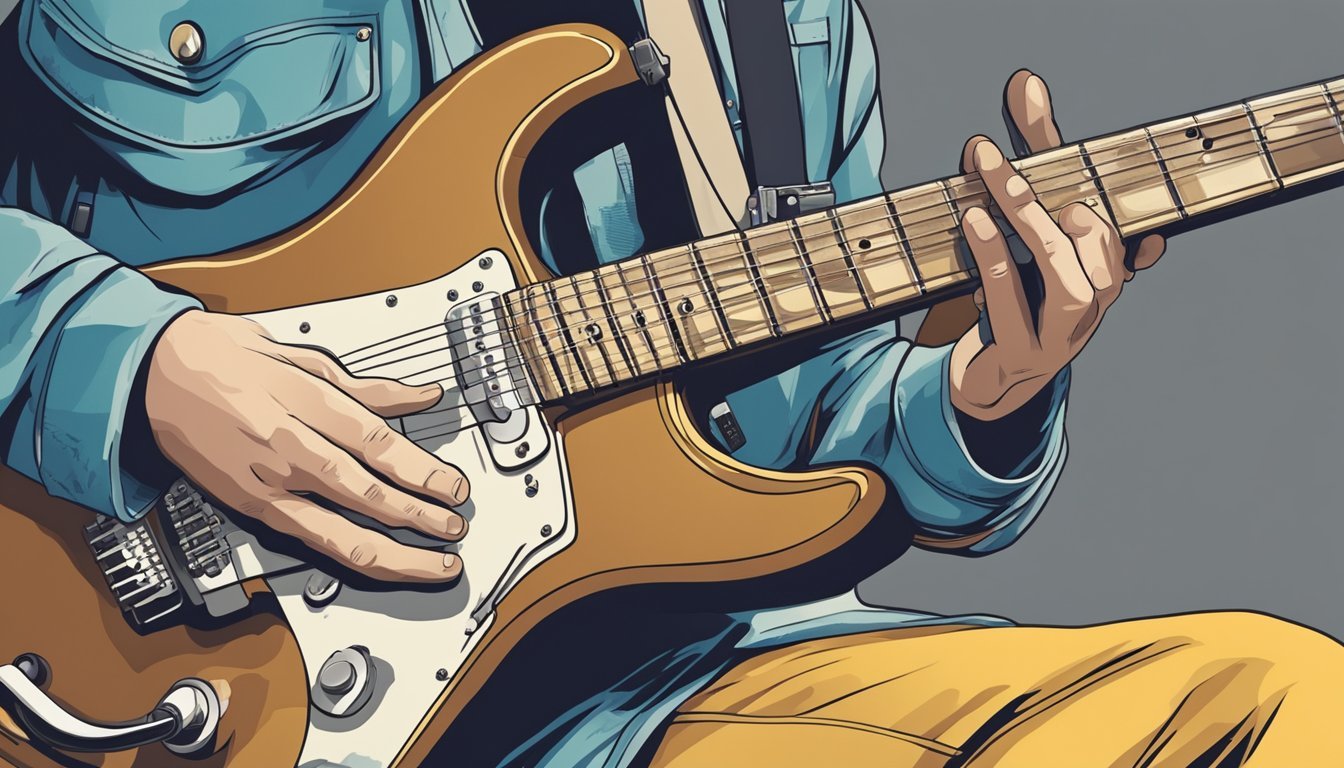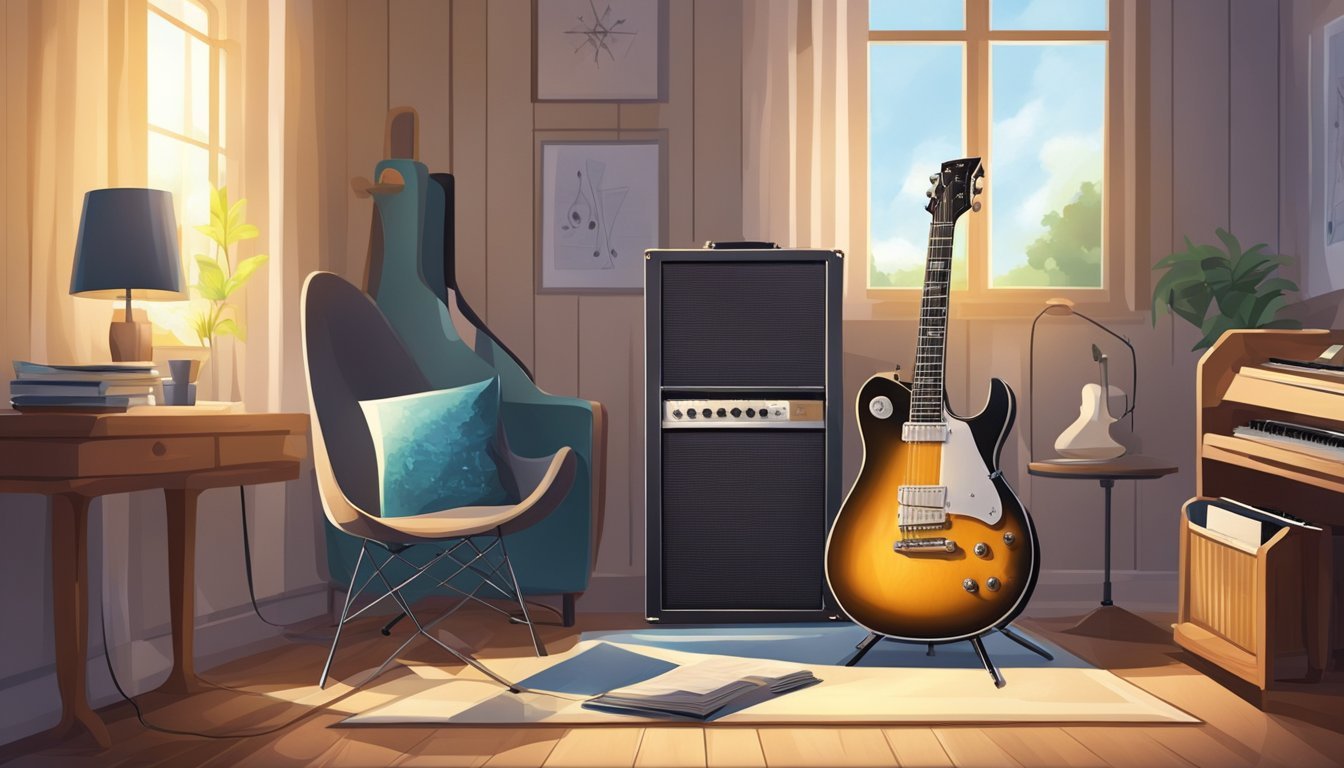Learning to play electric guitar can be an exciting journey.
To get started, you’ll need to understand the basics of the instrument, practice effective techniques, and gradually build your skills.
Whether you dream of rocking out in a band or just want to play your favorite songs at home, there’s a lot to explore.

Getting to know your electric guitar is essential.
Understanding the parts of the guitar and how they work will make your playing experience smoother and more enjoyable.
As you practice, focus on developing good habits that will help you progress faster and keep your practice sessions fun.
As you dive into the world of electric guitar, remember that everyone starts as a beginner.
With the right approach and resources, you can become a skilled player.
So, grab your guitar, and let’s start making music! It’s important to find a practice routine that works for you, as consistency is key to improvement.
There are plenty of online tutorials and instructional books available to guide you on how to start playing electric guitar, so take advantage of these resources.
Don’t hesitate to experiment with different styles and techniques; the journey will help you discover your unique sound along the way.
Key Takeaways
- Understand the fundamental parts and functions of your electric guitar.
- Practice regularly to develop your skills and techniques.
- Choose the right gear to enhance your playing experience.
Getting Started with Your Electric Guitar
Starting your journey with an electric guitar is exciting.
Knowing the main parts and setting up your space makes the process smoother.
Here’s how to get comfortable with your new instrument.
Understanding the Parts
Familiarizing yourself with your electric guitar’s parts is key.
This will help you understand how to play and maintain your guitar.
-
Body: The body of a solid-body guitar shapes the sound and feel of your instrument. It may vary in size and shape.
-
Neck: This is where you’ll need to press down on the strings to create notes. The fretboard sits on the neck.
-
Strings: Your guitar typically has six strings. Each one produces a different note when you pluck or strum it.
-
Pickups: These are located under the strings. They convert the vibrations into electrical signals, sending the sound to your amplifier.
-
Bridge: This part holds the strings in place and helps in tuning.
-
Machine Heads: Found at the headstock, these adjust the tension of the strings to keep your guitar in tune.
Understanding these parts will make it easier to handle your guitar as you play.
Setting Up Your Space
Creating a comfortable setup is essential.
This helps you stay focused while learning.
-
Amps and Cables: Connect your electric guitar to an amplifier using a guitar cable. This allows you to amplify the sound and adjust the volume.
-
Guitar Tuner: Use a guitar tuner to ensure your strings are tuned properly. This keeps your notes sounding clear and correct.
-
Strap: Getting a guitar strap will allow you to play standing up comfortably. Adjust the strap to fit your size.
-
Picks: Have several guitar picks on hand. The thickness and material can affect your playing style.
-
Case: Invest in a good case to protect your guitar when not in use.
Setting up your space right from the start will help make your practice sessions enjoyable and productive.
Playing Techniques
When you start playing electric guitar, certain techniques are crucial for making your experience enjoyable and effective.
You’ll need to focus on how to hold your guitar, where to place your fingers, and how to strum or pick the strings properly.
Holding the Guitar and Using a Pick
Start by holding your electric guitar comfortably.
If you’re sitting, rest the body on your right leg (for right-handed players).
If you’re standing, use a strap to keep it steady.
Make sure it’s at a height that allows you to reach the frets easily.
Using a pick can help you produce a clear sound.
Hold it firmly between your thumb and the first finger.
Angle it slightly against the strings for better vibration.
Practice strumming gently to get used to the movement and feel of the pick.
Remember, the pressure you apply makes a big difference in sound quality.
Finger Placement and Fretting
Once you’ve got your guitar ready, it’s important to know where to place your fingers.
Use the tips of your fingers to press down on the strings, just behind the frets.
This will create a clear note without buzzing.
Make sure you’re pressing hard enough, but not so hard that it hurts.
Practice simple chords like E minor or A major to get the hang of finger placement.
As you get more comfortable, try playing scale patterns; this helps improve your finger dexterity.
Remember to keep your fingers close to the fretboard while fretting to avoid muting other strings unintentionally.
Strumming and Picking
Strumming is a key technique for playing rhythm on your electric guitar.
You can use your pick or even fingers to strum the strings.
For a basic strum, sweep down across the strings in one smooth motion.
Experiment with patterns that fit the chord progressions you’re playing.
Picking is another essential skill, especially for certain styles of music.
You can pick individual strings to emphasize notes in a chord or melody.
Try practicing with different rhythms.
The more you practice strumming and picking, the better you’ll get at creating those vibrant sounds you want.
Don’t forget to have fun while you learn!
Essential Skills and Practice

To play electric guitar well, you need to focus on mastering chords and scales.
You’ll also want to explore various techniques and effects to develop your unique sound.
Learning Basic Chords and Scales
Start by learning basic chords like C, G, D, and A. These are the building blocks for most pop and rock songs.
Practice switching between them smoothly.
Next, work on scales.
The major and minor scales are essential.
They help with music theory and make soloing easier.
Use a metronome to improve your timing.
As you get comfortable, try adding in variations like pentatonic scales, popular in blues and rock.
Don’t forget to experiment with a capo.
This handy tool lets you change keys easily and explore new chord voicings.
With consistent practice, you’ll see improvement.
Developing Your Sound with Techniques and Effects
Your tone is shaped by both playing techniques and effects.
Start by experimenting with techniques like palm muting and fingerstyle.
These can give your playing a more dynamic feel.
Next, explore humbucker pickups for a fuller sound.
They offer a richer tone compared to single-coil pickups.
Use the tone controls on your guitar and amp to tweak your sound.
This is where you can dial in the right EQ for rock or jazz.
Adding effects like reverb, delay, or a whammy bar can elevate your playing.
They allow for a variety of sounds, enhancing your musical expression.
Play around with different combinations and watch how they change your tone and style.
Gear Selection and Maintenance
When starting your journey in electric guitar playing, choosing the right gear and keeping it well-maintained is crucial.
The right guitar and accessories can enhance your experience and help you learn effectively.
Choosing the Right Guitar and Equipment
Selecting your electric guitar is a big step.
If you’re a beginner, you might want to consider models like the Fender Stratocaster or Gibson Les Paul.
These are popular choices that offer great sound and playability.
Think about what type of music you want to play.
For rock, a humbucker pickup guitar is excellent, while single coils work well for country music.
Your equipment isn’t complete without an amp.
Look for something affordable with good quality sound.
A simple setup could include a basic instrument cable and reliable tuners.
Don’t forget picks! They come in various thicknesses, so try a few to find what feels best for you.
Upkeep and Troubleshooting
Now that you’ve got your gear, it’s vital to keep everything in good shape.
Regularly check your guitar strings for wear.
Change them often to keep your sound crisp.
Clean your guitar with a soft cloth to keep it free of dust.
For the fretboard, use a gentle cleaner to avoid damage.
Pay attention to the jack input and floating bridge or fixed bridge.
Troubles with these can affect playback.
If you notice buzzing or tuning issues, check your tuners and hardware.
Adjust your amp settings to experiment with channels for the best tone.
With dedication and care, your guitar will last and sound amazing for a long time!
Frequently Asked Questions
When you start learning electric guitar, you might have a lot of questions.
Here are some common queries that many beginners have regarding the basics, equipment, and self-learning resources.
What are the basic steps for beginners to learn electric guitar?
To get started, first, pick the right guitar.
Know the parts of the guitar and learn how to tune it properly.
Begin with basic chords and simple songs to build your skills.
Practice consistently to improve your finger strength and coordination.
Can I start playing electric guitar without using an amp?
Yes, you can play electric guitar without an amp.
Most electric guitars can be played quietly when they are not plugged in.
However, an amp enhances the sound and allows you to explore different tones.
It’s a good idea to use one as you progress.
Where can I find electric guitar tabs to practice?
A lot of websites offer free guitar tabs for popular songs.
You can check out sites like Ultimate Guitar, which has a large collection of tabs for different skill levels.
YouTube also has many tutorial videos that show you how to play specific songs.
What chords should I learn first when starting electric guitar?
Start with the basic open chords like G, C, D, E, A, and Em.
These chords are common in many songs and will help you play a variety of music.
Focus on changing between these chords smoothly to build your skill.
How can I teach myself electric guitar for free?
There are many resources available online for free.
Websites like YouTube have countless tutorials and lessons.
You can also find free courses on sites like Guitar Tricks that give you structured learning.
Just remember to practice regularly.
What are the essential notes and techniques I should know in electric guitar?
As a beginner, you should learn the names of the strings and basic music notes.
Familiarize yourself with techniques like strumming, picking, and bending notes.
Playing simple riffs and scales will also help you develop good habits from the start.

